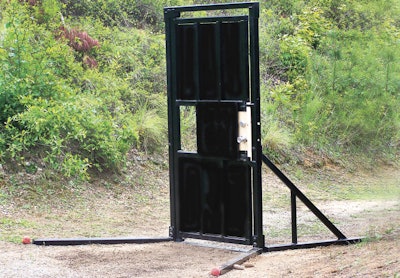 Photo courtesy of 6 Second Tactical.
Photo courtesy of 6 Second Tactical.
Brad Clewis, CEO of 6 Second Tactical, tells anyone who asks that he doesn't think of himself as an inventor or a business owner. He has never wanted to be anything other than a law enforcement officer, and that's what he is. But as a law enforcement officer, Clewis saw a problem and realized he could do something about it.
While serving on his North Carolina agency's tactical team in 2005, Lt. Clewis discovered that on-the-job breaching training was the order of the day. "We were getting ready for a search warrant brief. I hadn't been on the team very long and the team leader said to me, 'Tonight's your night to hit the door.' I said, 'What do you mean?' And he said, 'You're going to breach the door.'"
Clewis had never breached a door before, even in training. And from speaking with other tactical officers, he quickly realized that he wasn't alone. So he decided to do some research into what was available for breaching training.
After surveying the market, Clewis and his stepfather went to the drawing board. The final result was the All Purpose Breaching (APB) Door, a product so different from existing training doors that it's patented. Clewis calls his product the APB Door because one door can be used to train officers and firefighters to perform almost any form of breaching, using rams, hammers, shotguns, Hurst tools, and even door spreaders. He's even confident that the door can be used for explosive breaching training, although it hasn't been tested yet. In addition, the door can hang right or left and swing in or out. The legs are angled to provide a more realistic approach with less chance of tripping injury.
Like most training doors on the market, the APB Door is a stout piece of equipment. It's a heavy metal frame that weighs about 500 pounds and has a swinging metal door. But the differences between the APB door and its competitors are many.
Clewis wanted his door to be as functional and realistic a simulation as possible. So he designed a wooden insert that fits into the metal strike plate that can be easily duplicated by the door's users. Clewis explains, "I provide a template so you can drill it for doorknobs or for deadbolts, and you can insert 2x4s to simulate door jambs. If you want to use actual functioning locks, it works like a real door. Or if you don't want to pay for actual locks, you can use wooden dowels."
Some have questioned Clewis' use of non-proprietary materials on the APB Door, but he says, "The military has been using dowels to simulate door locks since World War II. My goal was to make the supplies affordable so that after you buy the door, you don't have to buy the stuff from me. We can supply the inserts or you can go to Home Depot, Lowe's, or your local hardware store and buy what you need."
Clewis says he's always thinking of new ways to improve the APB Door. One thing that he's looking into is creating a way officers can train to breach doors with buckshot. "In an active shooter situation, responding officers probably won’t have breaching rounds," he explains.
But Clewis says he can only spend so much time perfecting and marketing the APB Door. "I love being a law enforcement officer first and foremost," he says. "My ultimate goal is to get this product into as many officers' hands as possible while remaining on the front lines myself. I truly believe our product will save lives and that’s what this is all about."
Related:

















